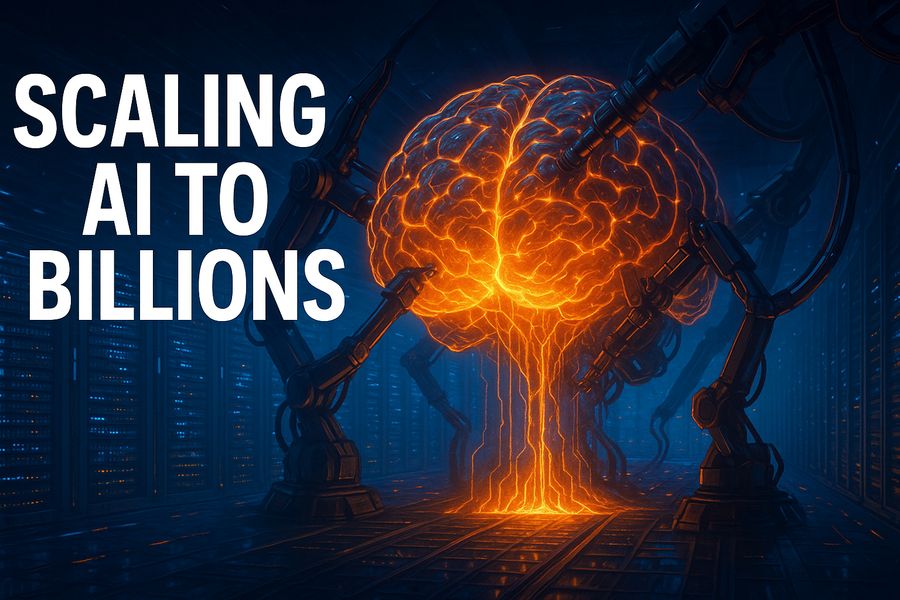As artificial intelligence advances, the demand for increasingly powerful models grows with it. Models like GPT-3 (175B parameters), GPT-4, and even larger successors represent a new era of deep learning — one where AI systems consist of hundreds of billions of parameters. But how do researchers and engineers actually train such massive systems?
This article breaks down the key techniques, challenges, and innovations behind scaling AI training for billion-parameter models. 💡🧠
🧠 What Are Billion-Parameter Models?
A parameter in a neural network is a weight that determines how the model processes information. The more parameters a model has, the more complex patterns it can learn.
🔍 Examples:
-
GPT-2: 1.5B parameters
-
GPT-3: 175B parameters
-
GPT-4: Estimated 500B+ parameters (as per industry speculation)
These models are capable of tasks ranging from text generation and translation to reasoning and problem-solving — but their power comes at a massive computational cost. 🏗️
🔄 The Challenge of Scaling
Training billion-parameter models is not just about stacking more layers — it involves orchestrating enormous compute infrastructure, managing data throughput, and preventing bottlenecks. Here’s why scaling is hard:
❗ Key Bottlenecks:
-
Memory Limits: A single GPU cannot hold all parameters.
-
Compute Power: Massive floating-point operations required.
-
Data Throughput: Models require trillions of tokens.
-
Time: Training can take weeks or even months.
Imagine trying to build a skyscraper using just hand tools — without specialized infrastructure, it’s nearly impossible. 🏢🔧
🖥️ Solution 1: Distributed Training 🧮
To scale up model training, engineers use distributed computing, which breaks the model and training data across many machines working in parallel.
📦 Parallelism Techniques:
-
Data Parallelism: Each machine (or GPU) processes a slice of the data.
-
Model Parallelism: The model itself is split across devices.
-
Pipeline Parallelism: Layers are distributed across devices and processed in stages.
-
Tensor Parallelism: Tensors (data structures) are split across GPUs for simultaneous processing.
These strategies are combined in hybrid approaches to maximize efficiency. 🧩
⚙️ Solution 2: High-Performance Hardware and Infrastructure 🖧
Training billion-parameter models demands cutting-edge hardware:
💻 Common Hardware Tools:
-
NVIDIA A100 GPUs: Industry standard for AI training.
-
TPUs (Tensor Processing Units): Google’s custom chips for deep learning.
-
NVLink / Infiniband: High-speed interconnects between GPUs.
☁️ Infrastructure:
-
Cloud Platforms: AWS, Azure, GCP for scalable training environments.
-
On-Premise Supercomputers: Custom-built AI training clusters (e.g., Microsoft’s AI supercomputer for OpenAI).
Without this massive infrastructure, training models of this size would be prohibitively slow or expensive. 🌐🔌
🧪 Solution 3: Optimized Training Algorithms 🧠
Advanced optimization techniques are used to reduce the cost and time of training without sacrificing performance.
Techniques Include:
-
Mixed Precision Training: Uses lower precision (e.g., float16) to reduce memory usage and speed up training.
-
Gradient Checkpointing: Saves memory by recomputing certain intermediate values on-the-fly.
-
Adaptive Learning Rates: Algorithms like AdamW fine-tune learning speed for different parts of the model.
-
Curriculum Learning: Easier examples are trained first, then harder ones, mimicking human learning.
These techniques allow models to be trained faster, cheaper, and more efficiently. ⏱️💡
🧱 Solution 4: Efficient Data Handling and Tokenization 📚
To train billion-parameter models effectively, they must be fed with massive volumes of high-quality data.
🔍 What’s Involved:
-
Tokenization: Breaking text into digestible chunks (tokens).
-
Shuffling: Ensuring variety in each training batch.
-
Streaming: Feeding data efficiently to avoid GPU idle time.
Companies use deduplicated, filtered, and balanced datasets to improve generalization and reduce bias. 📑⚖️
🔐 Safety, Bias, and Ethical Scaling 🛡️
Bigger doesn’t always mean better. As models scale, ethical risks scale too — including bias amplification, misinformation, and energy usage.
OpenAI and Other Researchers Implement:
-
Bias Audits
-
Red Teaming: Testing vulnerabilities and edge cases.
-
Alignment Training: Making models behave in line with human values.
-
Efficiency Benchmarks: Reducing carbon footprint via more efficient training methods.
🌍 Responsible scaling ensures that powerful AI systems don’t come at the expense of safety or sustainability.
🔁 Continuous Training and Fine-Tuning 🔄
After initial training, large models are often:
-
Fine-tuned on domain-specific data (e.g., legal, medical).
-
Updated to include new knowledge and facts.
-
Monitored for performance degradation or new safety concerns.
🎯 This ensures the model remains relevant, accurate, and aligned with changing human expectations.
🔮 The Future: Trillion-Parameter Models and Beyond 🧬
With continued breakthroughs in hardware, optimization, and algorithms, trillion-parameter models are already being explored.
What’s Coming:
-
Sparse Models: Only parts of the model activate per task, saving resources.
-
Modular Architectures: Combining smaller models for different tasks.
-
Federated Training: Leveraging decentralized data while preserving privacy.
📈 The future of scaling AI lies not only in size but also in efficiency, adaptability, and safety.
🚀 Final Thoughts
Scaling AI training for billion-parameter models is one of the most technically demanding and innovative achievements in modern computing. From specialized hardware and distributed systems to smart optimization techniques and ethical foresight, it requires the collaboration of engineers, researchers, ethicists, and cloud providers across the globe.
While the models get larger, the goal remains the same: building intelligent systems that can assist, understand, and empower humanity — responsibly. 🤝💡


